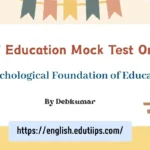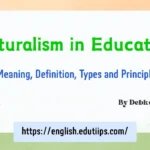Discover the meaning, definition and core principles of Pragmatism in education. Learn how experiential learning and student-centered teaching foster practical skills and critical thinking for real-world success.
Pragmatism is an educational theory that encourages students to construct knowledge through experience, rather than passively absorbing it. It believes in flexible curricula, interactive teaching, and a dynamic relationship between the learner and society.
Introduction of pragmatism in education
In the evolving landscape of modern education, Pragmatism stands out as a philosophy that blends practicality, adaptability, and experience-based learning. Rooted in the real world, it empowers learners to solve problems, develop critical thinking, and embrace continuous learning. As a foundation of progressive education,
Pragmatism, especially influenced by John Dewey, continues to shape teaching strategies worldwide.
The term ‘pragmatism’ first appeared in 1878 in “How to Make Our Ideas Clear”, an article of Charles Sanders Peirce.
The word pragmatism has been derived from the Greek word pragma, which means ‘to do’, ‘to make’, ‘to accomplish’, and ‘to act’. Therefore, the words ‘activity’, ‘action’, ‘practice’, ‘doing’, ‘making’ and ‘accomplishing’, etc., are used to refer to pragmatism.
Pragmatism is also known by various names such as “practical philosophy”, “utilitarian philosophy”, “experimental philosophy”, “philosophy of instrumentalism” and “philosophy of consequentialism”. Archie J. Bahm calls it “down-to-earth philosophy” and “cash value philosophy”.
Key Contributors to Pragmatism
The chief exponents or key contributors of pragmatism are Charles S. Peirce, William James, Schiller, John Dewey, Margaret H. Mead and W.H. Kilpatrick.
- John Dewey – The father of Pragmatic education, emphasized “learning by doing”
- William James – Promoted individual experience as the core of knowledge
- Charles Sanders Peirce – Introduced the concept of inquiry and experimentation
Pragmatism in Education Definition
Pragmatism is a modern ideology of education, defined by various philosophers. Notable definitions of pragmatism are mentioned below –
According to John Dewey – “Education is not preparation for life; education is life itself.”
According to James B. Prett – “Pragmatism offers us a theory of meaning, a theory of truth of knowledge and a theory of reality”.
According to Arnold Reid – “Pragmatism is an ‘activity’, ‘engagement’, ‘encounter’ based on the concept of practice or workability of an idea or theory”.
According to William James – “Pragmatism is a temper of mind, an attitude, it is also a theory of the nature of ideals and truth, and finally it is a theory about reality”.
So, Pragmatism is the doctrine that truth is the practical efficacy of an idea.
Types of Pragmatism in Education
Here are the main Types of Pragmatism in education –
Humanistic pragmatism
This form of pragmatism believes in the welfare of humanity. It is concerned with human needs, aspiration and satisfaction. It focuses on how knowledge and actions benefit human welfare and society.
Experimental pragmatism
According to experimental pragmatism, only those ideas or things are considered true that can be verified and proven through experiments. It stresses learning through experiments, observation, and practical activities.
Nominalistic pragmatism
According to medieval European nominalistic philosophy, “a universe is only a name”. Nominalistic pragmatism believes that these results of our experiments are always particular and concrete.
Biological pragmatism
According to this form of pragmatism, the power or capacity of a human being is valuable and important. Education must help learners adapt and survive in changing environments. In Education, it emphasises adaptability, critical thinking, and responsiveness to change.
Principles of Pragmatism in Education
According to Pragmatism, “whatever fulfils one’s purposes, satisfies one’s desire, and develops one’s life is true”. In fact, this philosophy is a mid-way between naturalism and idealism. Pragmatism’s main principles are as follows –
No ultimate values
The main principle of pragmatic philosophy is that has no ultimate values. Values such as truth, goodness and beauty are only man-made products. They are not fixed and they emerge only in the individual social-flow of events.
Learning by Doing
Pragmatism promotes hands-on activities that allow students to learn through real-world tasks, experiments, and problem-solving.
Truth changes
According to pragmatists truth always changes. They believe that what is true today may not necessarily be true tomorrow, what is true to one, may not necessarily be true or good to others.
Faith in democracy
Pragmatism has deep faith in democracy. An individual can realise the maximum development of his personality only in a social context. Therefore, he should acquire the qualities of social skills.
Faith in flexibility
Pragmatists have strong faith in flexibility. They believe that nothing is fixed and final in this world. Everything grows, changes and develops in course of time.
Advantages of Pragmatism in Education
Pragmatism is very important in modern education in many ways. The advantages of pragmatism are as follows –
- Encourages independent and critical thinking
- Promotes collaborative and social learning
- Builds practical life skills
- Fosters creative and innovative mindsets
- Aligns with modern career demands and skill development
Applications in Modern Classrooms
In modern education, the subjects that are followed in the classroom based on the principles of pragmatism are –
- Project-Based Learning (PBL)
- Case Studies and Simulations
- Interactive Digital Tools
- Group Problem-Solving Activities
- Flipped Classrooms and Blended Learning
Pragmatism philosophy of education Examples
Here are some real-world examples of the Pragmatism philosophy of education in action, with brief explanations to show how this philosophy is applied practically:
Project-Based Learning (PBL)
Students work in teams to solve a real-world problem—like designing an eco-friendly house or developing a small business plan.
📌 Example: A class creates a marketing campaign for a local product. They apply writing, math, and communication skills.
Conclusion
Hence, Pragmatism in education revolutionizes the traditional classroom by putting students at the center and encouraging them to learn through real-world experiences. In today’s fast-changing world, the pragmatic approach fosters skills, adaptability, and life-long learning—key ingredients for academic and professional success.
References
- Aggarwal, J. C., Theory and Principles of Education. 13th Ed. Vikas Publishing House Pvt. Ltd.
- V.R. Taneja, Educational Thoughts & Practice. Sterling Publication Pvt. Ltd. New Delhi
- Nayak, B.K, Text Book of Foundation of Education. Cuttack, Odisha: KitabMhal
- Ravi, S. Samuel, A Comprehensive Study of Education, Fourth Printing-May 2016, Delhi – 110092, ISBN – 978-81-203-4182-1,
- Pragmatism in Education
- Internet sources
Q – What is pragmatism in education
Ans – Pragmatism in education is a learner-centered and experience-based approach that promotes learning by doing. Instead of rote memorization, it emphasizes interaction with the environment, social learning, and the use of critical thinking to solve real-world challenges.





